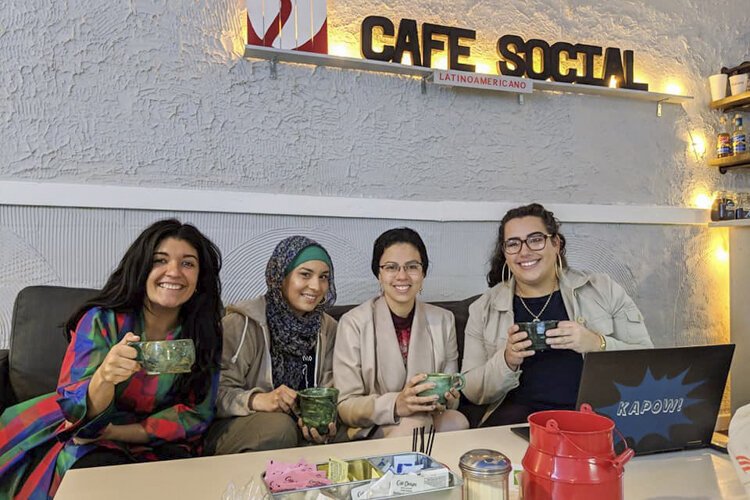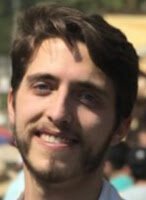The long-standing Hispanic social clubs of La Villa Hispana are finding new form for the future
For Gerardo Gomez, forming a club was born of necessity. When he first arrived in the United States from Puerto Rico at age 18, he was doubly tasked with finding work and mastering English. Cleveland’s manufacturing industries were booming, so Gomez found his American dream by way of Ford and Republic Steel. In 1962, he married his wife, Maria. They would go on to have two children, a son and a daughter.
Still, something in life was missing.
“I used to work, go to church, and that was it,” says Gomez, now 88. “I began to get an interest in starting something. An organization. I wanted to help people, but there was nothing like that around.”
In the summer of 1963, Gomez and fellow auto worker Moises Maldonado would birth one of the first Hispanic social clubs in the Clark-Fulton neighborhood. They called it Club San Lorenzo after their mutual city of origin. The club—which originally started as an asylum for homesick Puerto Ricans—grew into a bastion for Hispanic-led activism and traditional weekend dances.
 Throughout the 1960s and 1970s, other social clubs such as Club Lares and Club Alma Yaucana started to open their doors in Clark-Fulton—becoming partnering hubs of community and culture. A number of those clubs continue their presence in the neighborhood today, joined by a handful of 20-something Latinx leaders determined to redefine the 21st-century social club for La Villa Hispana and continue the deep legacy of connection.
Throughout the 1960s and 1970s, other social clubs such as Club Lares and Club Alma Yaucana started to open their doors in Clark-Fulton—becoming partnering hubs of community and culture. A number of those clubs continue their presence in the neighborhood today, joined by a handful of 20-something Latinx leaders determined to redefine the 21st-century social club for La Villa Hispana and continue the deep legacy of connection.
With this new generation of leaders hosting everything from Cuban-themed themed dance fundraisers to cleanup days in Clark-Fulton, the rising steam behind key players begs the question: What can La Villa Hispana accomplish today that couldn't be decades ago?
Rise to relevance
Over the decades, Club San Lorenzo became more than just a gathering spot under the socially conscious leadership of Gomez and Maldonado. The club also expanded during a national Chicano Movement (“El Movimento”) amid concerns for Latino civil rights.
 Four years after opening, the duo would form the Spanish-American Committee—the first Hispanic group of its kind in Ohio—as the Club’s social service-focused offshoot, aiding Third Wave Puerto Ricans in homebuying and English fluency. A Bilingual Parent Union and Miss Latina pageants would sprout up soon after.
Four years after opening, the duo would form the Spanish-American Committee—the first Hispanic group of its kind in Ohio—as the Club’s social service-focused offshoot, aiding Third Wave Puerto Ricans in homebuying and English fluency. A Bilingual Parent Union and Miss Latina pageants would sprout up soon after.
Of course, this all ran simultaneous with typical festivities.
“Oh man! Everyone would be playing dominoes and cards,” says Juan Molina Crespo, who grew up going to San Lorenzo with his father. "You’d hear, for the most part, trios playing boleros and merengues. And for the guys missing their wives back on the island? Think of Humphrey Bogart—this brooding, lonely hard drinker."
Throughout the 1960s and 1970s, Gomez and other leaders found a tight-knit community tough to maintain as Third Wave Hispanics accumulated wealth and relocated to the suburbs. Still, during dire straits, San Lorenzo would gather funds to help recent arrivals assimilate or send a deceased loved one back to the island.
 In December of 1972, after Pirates pitcher Roberto Clemente died in a plane crash, Gomez chartered a bus of Club members to Pittsburgh, as his daughter Magda Gomez recalls, “just to comfort his widow.”
In December of 1972, after Pirates pitcher Roberto Clemente died in a plane crash, Gomez chartered a bus of Club members to Pittsburgh, as his daughter Magda Gomez recalls, “just to comfort his widow.”
Currently the head of Diversity & Inclusion at Cuyahoga Community College, Magda Gomez vividly recalls going to Club San Lorenzo as a child in the 1960s and 70s. She says her father’s penchant for community organizing birthed not just her own aspirations, but influenced a trove of others.
“Every block club I’ve organized comes from [him],” she says. “There’s no better way, I think, to learn civic responsibility.”
"For the enhancement of society"
As far as Lydia Caraballo remembers, Club Alma Yaucana started with a mantra: To promote unity and fraternity, to contribute to the enhancement of society, and to provide assistance to its members.
 Although Caraballo didn’t get officially involved with Alma Yaucana—named for the city of Yauco, Puerto Rico—until 1989, she can describe the purpose of the club in vast detail, one akin to that of Gomez’s original mission. The sentiment would encourage Caraballo, who has spent most of her adult life as a teacher and a lab technician, to act as club president in the 1990s, with a deep appreciation for those who'd paved the way.
Although Caraballo didn’t get officially involved with Alma Yaucana—named for the city of Yauco, Puerto Rico—until 1989, she can describe the purpose of the club in vast detail, one akin to that of Gomez’s original mission. The sentiment would encourage Caraballo, who has spent most of her adult life as a teacher and a lab technician, to act as club president in the 1990s, with a deep appreciation for those who'd paved the way.
“Problems in the 1960s were more difficult,” says Caraballo, who moved to Clark-Fulton in 1957 and now serves as Alma Yaucana's treasurer. “In those days, there wasn’t a lot of help for people coming here compared to what it is now; we were really on our own. We just had to work harder, but [we] did it.”
Like Club San Lorenzo, Alma Yaucana is, Caraballo notes, attempting to adapt to the needs of a different era.
For one, Alma Yaucana is trying to expand its group of 60 members beyond the Puerto Rican diaspora to other include Latin Americans. DJs playing reggaeton have, for the most part, replaced weekend merengue (though live salsa comes through on Sundays), and the food is still the same: hot empanadillas, rice, tostones, and the occasional trays of fried chicken.
One of the reasons Caraballo remains committed to keeping Alma Yaucana alive is the healthy outlet it provides for Clark-Fulton’s youth. “When a youngster is involved in good activities, nice things, volunteering, and helping people, their mind is putting good things out,” she says. “They’re less bound to run into trouble.”

Battling old stigmas
For someone with three jobs, 24-year-old Selina Pagan is anything but tired.
As head of the Young Latino Network, Pagan leads a weekly social on hot button topics she calls Café con Leche, a two-hour conversational free-for-all currently situated at the Los Dos Fronteras restaurant off of Fulton. At a recent “LGBT Awareness”-themed gathering, Pagan praised the recent grand opening of the LGBT Center in Gordon Square, providing a segue to pique thoughtful discussion on how to widen the Latin community’s acceptance of the LGBT community.
“A stigma in our culture that runs deep to this day,” she told the dozen attendees.

A woman in her 40s who wished not to be identified said she was troubled with the Puerto Rican concept of jamonas, women in their late 30s who had never had children.
“We always think that holy matrimony is the painkiller for everything,” she says. “‘You gotta get married, or what are people gonna think!’ This is just ridiculous, but this is how people really think.”
“That’s why we have to talk about it,” Pagan responded from the head of the table. “Now, who else has a story?”
The roots of Pagan’s natural leadership skills run deep. Stemming from an entrepreneurial family from Quedabrillas, Puerto Rico, Pagan found her aspirations as a community organizer in college. Under Crespo’s tutelage, she interned for four years at the Hispanic Alliance while studying at Cleveland State, fostering connections that would encourage her to join—and then head—YLN (while still working at her parents’ jewelry store).
Witnessing a swath of “black and brown businesses” lacking up-to-date strategies, Pagan pushed her reach further, and created SMP Consult(a) as her own foray into the entrepreneurial world.
 “There are a lot of people with closed minds, who don’t think out of the box,” says Selina’s mother, Sandra Pagan. “That’s Selina’s passion: to change people’s minds.”
“There are a lot of people with closed minds, who don’t think out of the box,” says Selina’s mother, Sandra Pagan. “That’s Selina’s passion: to change people’s minds.”
Although Pagan admits that she’s “young and wet behind the ears,” she’s one of Clark-Fulton’s go-to examples of youth bridging cultural gaps. She encourages skeptical neighbors to register to vote via YLN pop-ups, and others to give accurate personal data on the forthcoming U.S. Census (“Black, brown, or light? Latinas just ain’t white,” reads a poster Pagan championed at the meeting).
Along with hosting Noche de Guayabera on July 19 (a fundraiser for leadership development programming) and voting advocacy at August's Puerto Rican Day Parade, Pagan seeks to continue to grow YLN's 300-strong membership base, which now includes Cleveland 19's Jorge Ramos Pantoja and JumpStart project manager Roberta Duarte. She'll push Cafe con Leche further with other topical themes, expand diplomacy into other neighborhoods (AsiaTown as of recent), all while reminding herself to have fun in the process.
“Sometimes those spaces are needed to just have a drink and go hang out with your friends, right?” she says. “Not to always have to deal with all the bigger picture problems.”
This article is part of our On the Ground - La Villa Hispana community reporting project in partnership with Dollar Bank, Hispanic Business Center, Esperanza Inc., Greater Cleveland Partnership, Cleveland Neighborhood Progress, and Cleveland Development Advisors. Read the rest of our coverage here.








